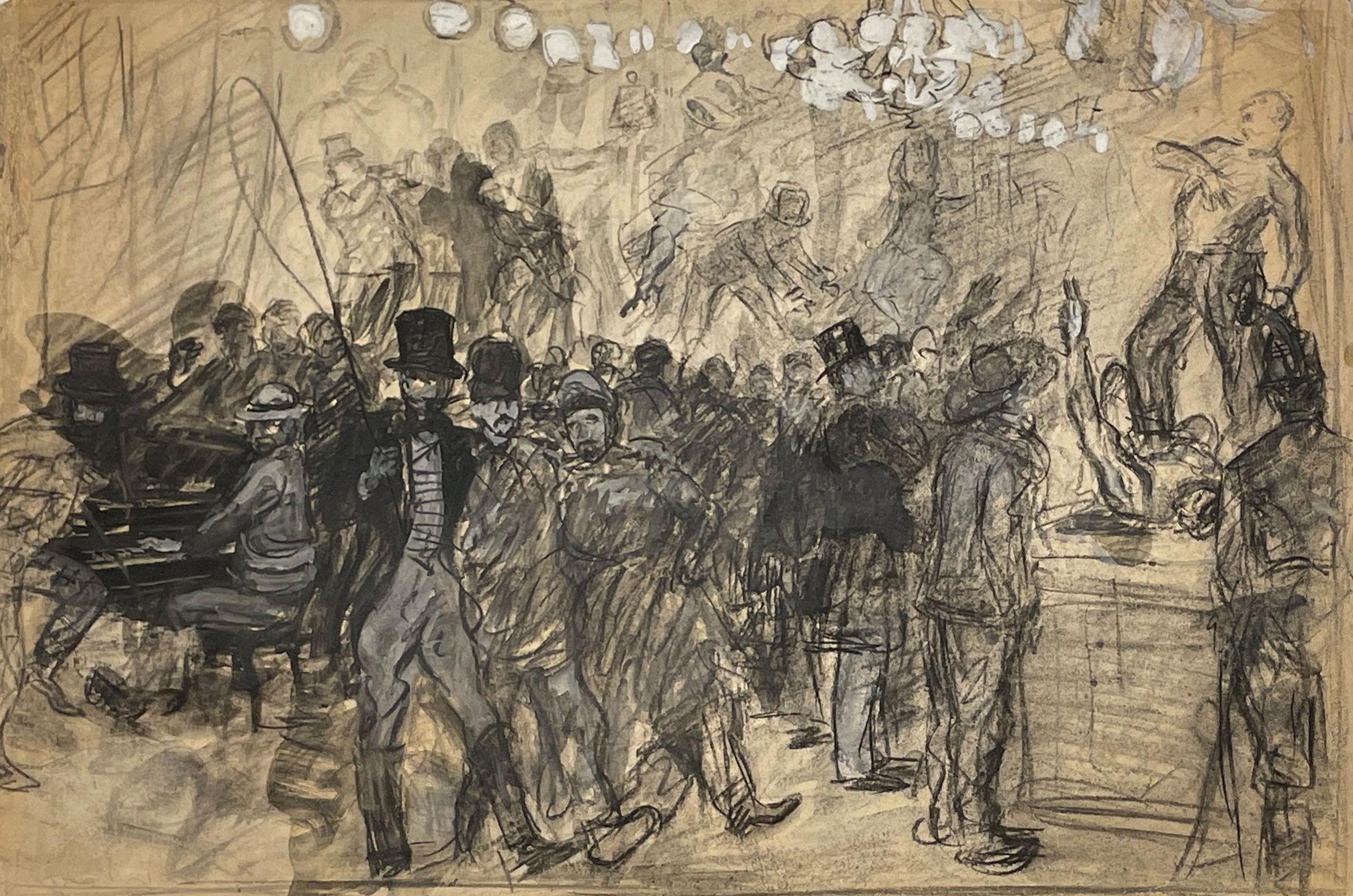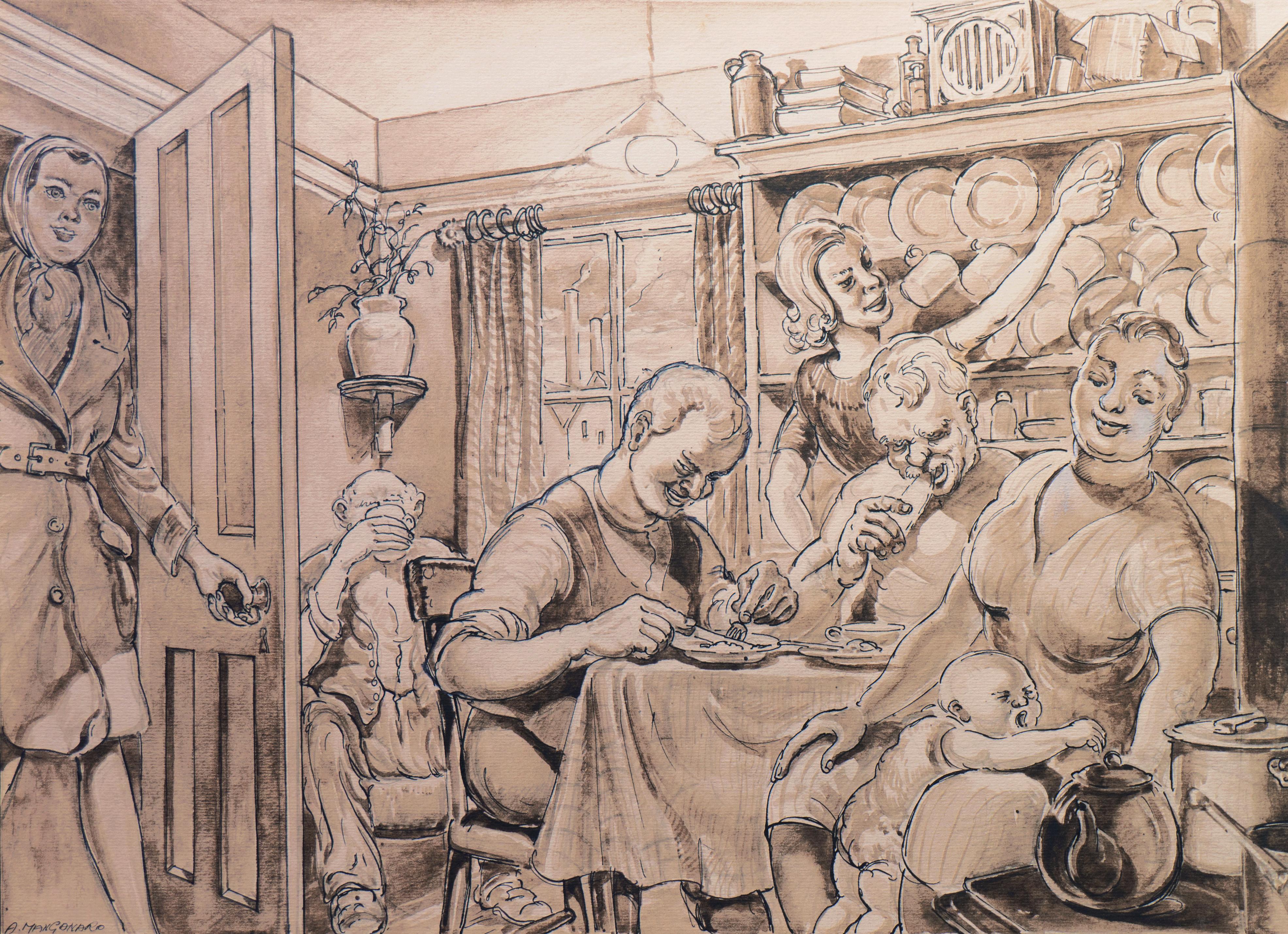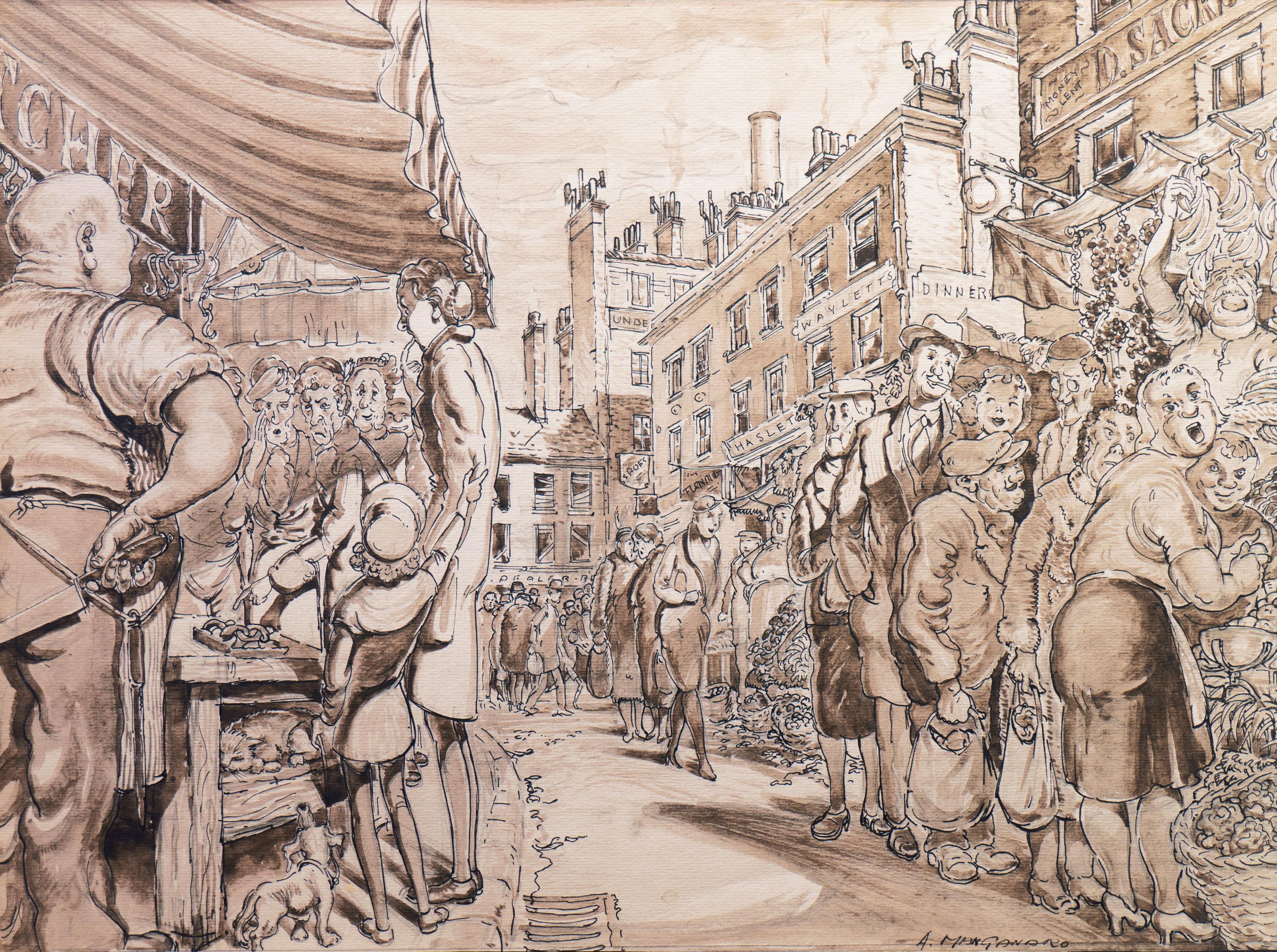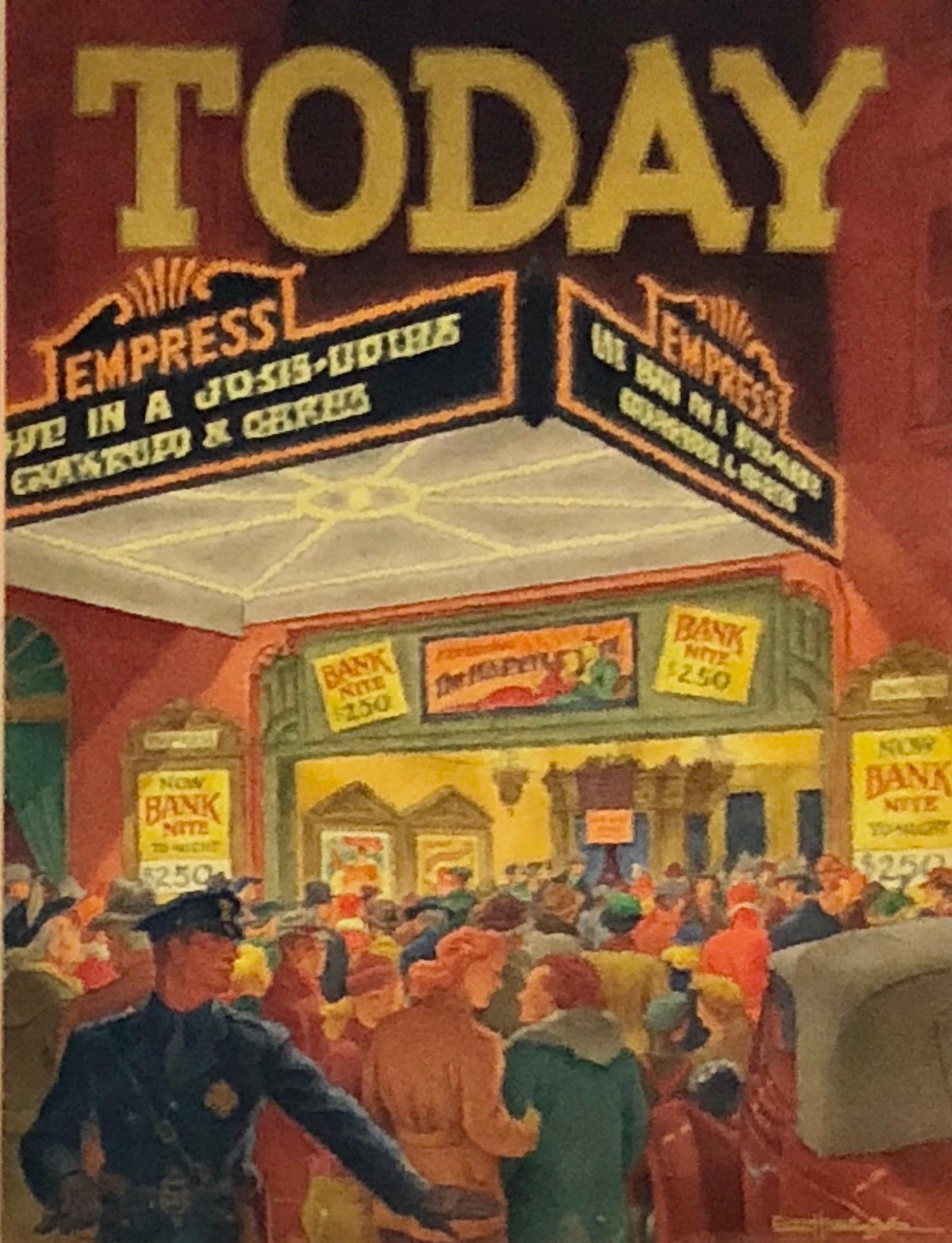Items Similar to 1854 Funeral of R. Williams at Gyokusen-ji Temple, Shimoda, with Commodore Perry
Want more images or videos?
Request additional images or videos from the seller
1 of 8
Wilhelm Heine1854 Funeral of R. Williams at Gyokusen-ji Temple, Shimoda, with Commodore PerryCirca 1854
Circa 1854
About the Item
Wilhelm Heine (Dresden 30 January 1827-Löbnitz 5 October 1885)
‘Funeral of Robert Williams in the cemetery of the Temple Gyokusen-ji at Shimoda in April 1854’
With a sticker on the reverse of the frame by Coupil & Co. 1855
Watercolour on paper, H. 57 x W. 92 cm
Depicted is the Bay of Shimoda with seven American ships including the two paddle-wheel warships USS Mississippi and Susquehanna. On the Gyokus- en-ji temple grounds on the right is the coffin in the middle with the remains of US marine Robert Williams, ready to be lowered into the grave. Looking on from the left are the Buddhist monks and Japanese officials who joined the first Christian funeral on Japanese soil. Around the grave are US marines, Commodore Perry and some officers and to the right, Reverend George Jones is performing the Christian funeral rites. This was an epoch-making moment in the history of Japan.
Wilhelm Heine after studying at the Dresdner Akademie in 1848-49 received his first commission from Richard Wagner, a family friend, to design décors for the Königlichen Hoftheater in Dresden. In 1849 he fled to the United States following the suppression of the May Uprising in Dresden in which he participated (together with Bakunin). In New York, he set up his artist studio at 515 Broadway. After meeting the archaeologist and diplomat, Ephraim George Squier, Heine was invited to accompany him, as an artist, on his consular duties to Central America, to investigate the possibilities of a canal through Nicaragua. Proceeding ahead of Squier, he stood in as consul, negotiating commercial agreements between Central American countries and the United States, which he delivered to Washington. While in Washington he met with President Millard Fillmore and Commodore Perry and was selected for the post of the official artist of the Perry expedition
to Japan.
Heine served on the flagship USS Mississippi and visited Okinawa, the Bonin Islands, Yokohama, Shimoda and Hakodate in1853 and 1854. The sketches and paintings he made of the places he visited and the people he met, together with the daguerreotypes taken by his colleague Eliphalet Brown jr formed the basis of an official iconography of the first American expedition to Japan. Back in New York in 1855, he published several books, including 'Graphic Scenes of the Japan Expedition', in which many of his paintings were lithographed, but not the present painting. At present only three of the original painting made during this expedition have been retraced in the USA. In 1855 Heine became an American citizen.
Heine went back to Germany where he instigated and joined the Prussian Expedition to East Asia in 1859. Again Heine made many sketches and paintings while in Japan. In 1861, at the outbreak of the Civil War in the United States, Heine returned to the USA and joined the Union Army. He was wounded in battle and returned to Germany for treatment.
After the war Heine became clerk to the American consul in Paris, Liverpool and in his home town Dresden. In Dresden Heine published his last major work 'Japan, Beiträge zur Kenntnis des Landes und seiner Bewohner' with many photo-reproductions of his drawings, published in a very expensive small edition by C.C. Meinhold & Söhne, ordered by subscription by German and Austrian Emperors, kings and dukes. In this luxury edition is a photo-lithograph entitled 'Grabstätte in Simoda' which shows the cemetery of the Temple Gyokusen-ji at Shimoda but doesn’t show an actual funeral as the present painting does.
After his death 41 of the then remaining 50 original paintings were donated by his son-in-law to the Museum Fünf Kontinente in Munich. Of the unknown number of original paintings Wilhelm Heine made during his first expedition to Japan under Commodore Perry, and subsequently left behind in the USA, at present three are known: one “American sailors and marines drilling in the temple grounds at Shimoda, June 8 1854” (49 x 94 cm) in the Collection of Brown University Library, Providence, Rhode Island, USA, one in a private collection in the USA, and the present one.
Coupil & Co, whose sticker is on the frame, was one of the most prominent prints and art dealers of the 19th century. Initially established in Paris in 1829, Goupil expanded to London in 1842, to New York in 1848, and went on to develop an extensive network of branches and partnerships worldwide.
- Creator:Wilhelm Heine (1827 - 1885)
- Creation Year:Circa 1854
- Dimensions:Height: 22.45 in (57 cm)Width: 36.23 in (92 cm)Depth: 0.08 in (2 mm)
- Medium:
- Period:
- Framing:Framing Options Available
- Condition:Slight discolouration of the paper, which can easily be restored, some foxing but no big damages.
- Gallery Location:Amsterdam, NL
- Reference Number:1stDibs: LU1471210571872
About the Seller
No Reviews Yet
Vetted Seller
These experienced sellers undergo a comprehensive evaluation by our team of in-house experts.
1stDibs seller since 2021
- ShippingRetrieving quote...Ships From: Amsterdam, Netherlands
- Return PolicyA return for this item may be initiated within 7 days of delivery.
More From This SellerView All
- Portrait of a Slave Ship: 'Le Negrito à l’ancre. Dans le port de la havanne'Located in Amsterdam, NLFRANÇOIS MATHURIN ADALBERT, BARON DE COURCY (1805-1839) 'Le Negrito à l’ancre. Dans le port de la havanne' Indistinctly signed lower left Titled on the mount Pencil and watercolour, heightened with white, on paper, 24.8 x 34.6 cm Literature: The present watercolour will be illustrated in: - Prof. Manuel Garcia’s projected book on the disease and the slave trade provisionally titled “Fighting the Yellow Demon of Fever: The Struggle against Disease in the Illegal Slave Trade”. - Prof. Micael Zeuske’s forthcoming Global history of slave trade. Exhibited: Mexico City, 1998, Palacio Virreinal, El Barón de Courcy, illustrationes de un viaje, 1831-1833, no. 108 Note: Baron de Courcy was in the Caribbean in late 1832 and early 1833, following his tour of Mexico in 1832, on the last leg of his “Grand Voyage...Category
Mid-19th Century Old Masters Figurative Drawings and Watercolors
MaterialsGouache, Pencil, Paper, Watercolor
- Devotion in the Dessert near the pyramids of Gizeh, circa 1919By Marius BauerLocated in Amsterdam, NLMarius Bauer (1867-1932) ‘Devotie in de Woestijn’ (Devotion in the Dessert near the pyramids of Gizeh, circa 1919) Signed lower right and titled lower left Watercolour on paper, H...Category
Early 20th Century Impressionist Landscape Drawings and Watercolors
MaterialsPaper, Ink, Watercolor, Pencil
- Borobudur, Java, Indonesia (1937)Located in Amsterdam, NLGraveyard with in the background the Borobudur, 1937 Signed with initials and dated bottom left Pencil and ink on paper, 33 x 29 cm In ebonized frame with white mount Literature: ...Category
1930s Art Nouveau Landscape Drawings and Watercolors
MaterialsPaper, Ink, Graphite
- Wobbly bridge, Tabanan, Bali, 1937Located in Amsterdam, NLWobbly bridge, Tabanan, Bali, 1937 Signed with initials bottom right and dated, bottom left Pencil and ink on paper, 22 x 26.3 cm In ebonized frame with white mount Willem Otto Wi...Category
1930s Art Nouveau Landscape Drawings and Watercolors
MaterialsIndia Ink, Paper, Pencil
- Beach of Kusambe, Bali 1937Located in Amsterdam, NLFour outrigger proa’s on the beach of Kusambe, Bali, 1937 Signed with initials, dated and described with location bottom left Pencil and ink on paper, 29.7 x 35 cm In ebonized frame with white mount WILLEM OTTO WIJNAND NIEUWENKAMP (1874-1950) Nieuwenkamp was born on July 27th 1874 in Amsterdam. His father owned sailing ships sailing to Indonesia and hearing the stories of the returning captains evoked in the young Nieuwenkamp an obsession for distant lands and adventure. After a failed attempt by his father to have his son make a career in his business, Nieuwenkamp attended the Academy for Decorative Art in Amsterdam. However, he left within one year to go his own way. He was an autodidact and a great experimenter with new techniques, particularly in the art of etching. Nieuwenkamp was a very focused man with the discipline of a scientist tempered by the sensitivity of an artist, a lust for adventure, a natural appreciation for ethnic arts and an enormous ambition to tread new paths. In 1898 he visited Indonesia for the first time and on his second visit in 1903-1904 he went on to Bali and became the first foreign artist to love Bali and the Balinese with a passion. Having secured agreements with several museums in the Netherlands to obtain Balinese art and objects for their collections, Nieuwenkamp immediately started to purchase and order a wide range of ethnographic art and objects from local artists and craftsmen. Through his drawings and books, he gave an excellent impression of Balinese art and culture at that time. Since 1854 Northern Bali was under Dutch...Category
1930s Art Nouveau Landscape Drawings and Watercolors
MaterialsIndia Ink, Paper, Pencil
- Statue of Vishnu Garuda, Bali, 1904Located in Amsterdam, NLStatue of Vishnu Garuda, Bali, 1904 Signed with initials Pencil and ink on paper, 21.4 x 21.3 cm Literature: Bruce W. Carpenter, W.O.J. Nieuwenkamp. First European Artist in Bali,...Category
Early 1900s Art Nouveau Landscape Drawings and Watercolors
MaterialsPencil, Paper, India Ink
You May Also Like
- "Street Fair” William Glackens, Ashcan School, Street Scene, Carnival, BoxingBy William GlackensLocated in New York, NYWilliam Glackens Street Fair, circa 1905 Pencil, ink and gouache on paper 10 x 14 inches Provenance: The artist Kraushaar Galleries, New York Estate ...Category
Early 1900s Ashcan School Landscape Drawings and Watercolors
MaterialsGouache, Pencil, Paper, Ink
- 'The Working Class Enjoying a Meal', Satire of Capitalism, ProletarianBy Antonio ManganaroLocated in Santa Cruz, CASigned lower left, 'A. Manganaro' for 'Antonio Manganaro (Italian, 20th Century), and titled lower center, 'Ability of the Working Classes to Enjoy Meals Under Humble Surroundings'. ...Category
Mid-20th Century Realist Figurative Drawings and Watercolors
MaterialsPaper, Ink, Gouache, Pen, Graphite
- 'The Enduring Attractions of the Open Market', Capitalism SatireBy Antonio ManganaroLocated in Santa Cruz, CASigned lower right, 'A. Manganaro' for 'Antonio Manganaro (Italian, 20th Century), and titled lower center, 'The Enduring Attractions of the Open Market'. Matted Dimensions: 16 x 20Category
Mid-20th Century Realist Figurative Drawings and Watercolors
MaterialsGouache, Pen, Graphite, Paper, Ink
- Magazine Cover Illustration Mid 20th Century Modern Theatre Broadway Realism WPABy Ernest Hamlin BakerLocated in New York, NYMagazine Cover Illustration Mid 20th Century Modern Theatre Broadway Realism WPA Ernest Hamlin Baker (1889 – 1975) “Today Magazine” Cover ...Category
1930s American Modern Figurative Drawings and Watercolors
MaterialsGouache, Paper, Watercolor, Ink
- Children Snow Sledding in Central Park - New Yorker Cover StudyLocated in Miami, FLHungarian/American artist/illustrator depicts a charming scene of sledding in the snow in Central Park. The work is abstract in its design as it's functional in its narrative - Unpublished New Yorker...Category
1940s Modern Figurative Drawings and Watercolors
MaterialsCharcoal, Ink, Watercolor, Gouache, Pencil
- Environmental Prognostication Coil Narrative "Homo Sapiens R.I.P."Located in Miami, FL"They paved paradise and put up a parking lot," Joni Mitchell said. - - Created in 1969, at the dawn of the American environmental movement, artist Richard Erdoes draws a sequential narrative in the form of a coil. From inception to destruction, it illustrates a list of things that humans are doing to destroy the world we live in. The work was commissioned for school-age humans and executed in a whimsically comic way. Yet the underlying narrative is sophisticated and foreshadows a world that could be on the brink of ecological disaster. Graphically and conceptually, this work exhibits an endless amount of creativity and Erdoes cartoony style is one to fall in love with. Signed lower right. Unframed 12.4 inches Width: 12.85 inches Height is the live area. Board is 16x22 inches. Richard Erdoes (Hungarian Erdős, German Erdös; July 7, 1912 – July 16, 2008) was an American artist, photographer, illustrator and author. Early life Erdoes was born in Frankfurt,to Maria Josefa Schrom on July 7, 1912. His father, Richárd Erdős Sr., was a Jewish Hungarian opera singer who had died a few weeks earlier in Budapest on June 9, 1912.After his birth, his mother lived with her sister, the Viennese actress Leopoldine ("Poldi") Sangora,He described himself as "equal parts Austrian, Hungarian and German, as well as equal parts Catholic, Protestant and Jew..."[4] Career He was a student at the Berlin Academy of Art in 1933, when Adolf Hitler came to power. He was involved in a small underground paper where he published anti-Hitler political cartoons which attracted the attention of the Nazi regime. He fled Germany with a price on his head. Back in Vienna, he continued his training at the Kunstgewerbeschule, now the University of Applied Arts, Vienna.[5] He also wrote and illustrated children's books and worked as a caricaturist for Tag and Stunde, anti-Nazi newspapers. After the Anschluss of Austria in 1938 he fled again, first to Paris, where he studied at the Academie de la Grande Chaumiere, and then London, England before journeying to the United States. He married his first wife, fellow artist Elsie Schulhof (d. xxxx) in London, shortly before their arrival in New York City. In New York City, Erdoes enjoyed a long career as a commercial artist, and was known for his highly detailed, whimsical drawings. He created illustrations for such magazines as Stage, Fortune, Pageant, Gourmet, Harper's Bazaar, Sports Illustrated, The New York Times, Time, National Geographic and Life Magazine, where he met his second wife, Jean Sternbergh (d. 1995) who was an art director there. The couple married in 1951 and had three children.[6] Erdoes also illustrated many children's books. An assignment for Life in 1967 took Erdoes to the Pine Ridge Indian Reservation for the first time, and marked the beginning of the work for which he would be best known. Erdoes was fascinated by Native American culture, outraged at the conditions on the reservation and deeply moved by the Civil Rights Movement that was raging at the time. He wrote histories, collections of Native American stories...Category
1960s American Realist Landscape Drawings and Watercolors
MaterialsInk, Gouache, Illustration Board
Recently Viewed
View AllMore Ways To Browse
Washington At Home
R Waring
Paris Watercolor Prints
Union Of London
Sets Of Watercolor Prints
Ships At War
Us Marines
Us Marine
Antique Watercolor Set
Most Expensive Painting
Temple London
Battle Of York
American 19th Century Watercolors
Most Expensive Original Paintings
T H R
C Williams
Williams Antique
Small Midcentury Watercolors





